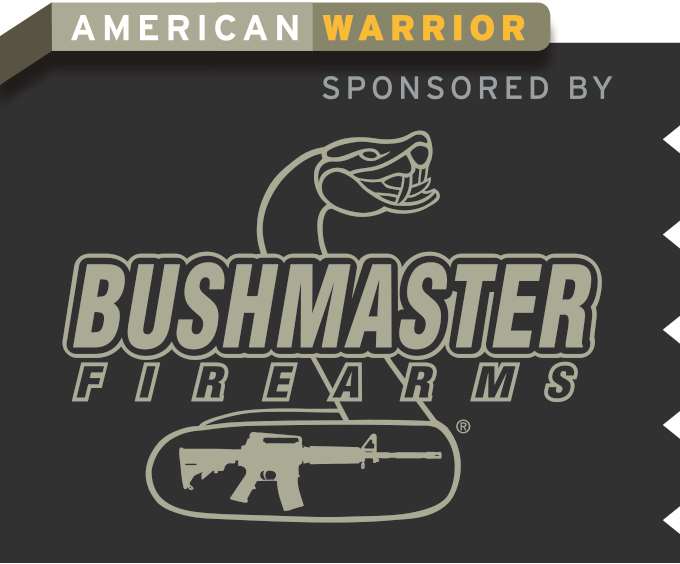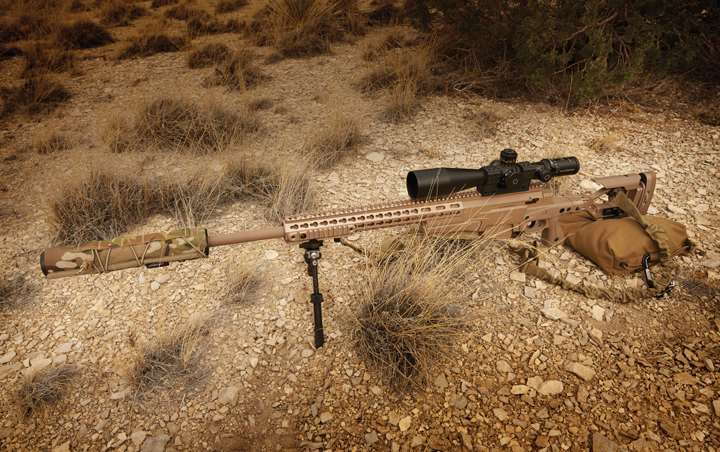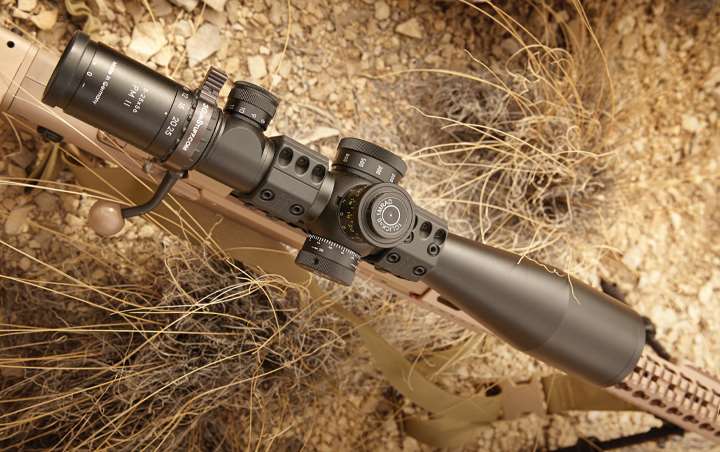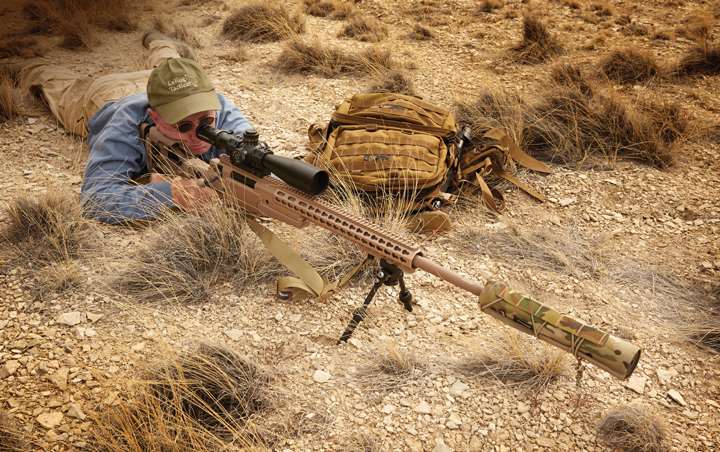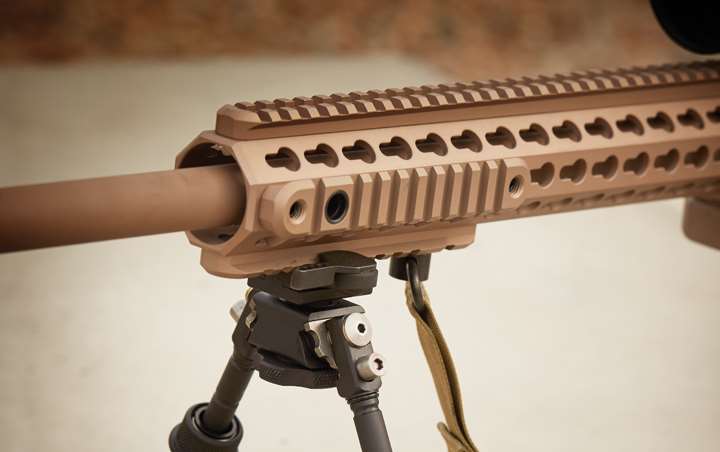
If you walk into just about any pub on either side of the Atlantic, asking for a Black & Tan will get you a layered pint of Guinness and Harp beer. But if you walk into a gun store, the same request might just get you an Accuracy International PSR. (Be warned that ordering a Black & Tan in Ireland might get you punched, or, at the very least, a healthy glob of saliva in your pint glass.)
Imported from the U.K., the PSR is Accuracy International’s submission to the United States Special Operations Command as a replacement for its Remington 700-based sniper rifles. A multi-caliber rifle chambered in .308, .300 Win. Mag. and .338 Lapua, the PSR is not just a rebarrel of the company’s AX rifle—lots of things have changed.
The rifle comes in a large, heavy-duty rolling case made by Becklin Holdings Inc., complete with custom-inletted, high-density foam. The two spare bolt bodies were tucked in the foam nice and tight. Nine magazines—three for each caliber—were included, as was a scope mount, Armageddon Gear sling, Harris bi-pod, Eberlestock soft carry case, cleaning kit and a one-piece cleaning rod. With a scoped rifle and a couple of spare barrels in the case, the whole thing weighs in around 65 to 70 pounds, with about 18 of that being the rifle.
The heart of any firearm that uses magazines is the mag itself. For bolt-action rifles, Accuracy International mags are the gold standard. All three flavors of mags for the PSR are 10-round, double-stack mags, coated to prevent rust.
Getting a .308 magazine to work in a .338 Lapua-length action took some head scratching. The engineers at AI came up with a magazine well filler and release to make the rifle think it has a long-action magazine installed. If you look at the right side of the rifle, you can see a small hole at the top of the magazine well. That’s where the mag block snaps in. To remove the block, simply depress the button with a bullet and pull the block out. With the block removed, the .300 and .338 magazines lock in with no issue.
The action itself is a bit wider than a normal AI Magnum action, and the barrel threads are beefier as well. All the PSR barrels are smithed by the very talented gunsmithDaveTooley,who has an extensive background in building long-range rifles. Many 600- and 1,000-yard bench rest records have been set with Dave’s rifles. And while the PSR is not a Dave Tooley custom rifle or a 1,000-yard bench rest rifle, knowing Tooley had an impact on the finished product makes me smile.
Like most Accuracy International rifles, this action is bonded (glued) and screwed to the chassis to keep things from working loose. The bolt is a three-lug design, allowing for a shorter bolt throw. That’s not always a big deal, but with big scopes or gloves on it helps. The rifle’s scope-mounting rail has 30 MOA cant built into it. This allows you to sight in up close and still have enough elevation clicks left to make hits at long range.
AI put a top-notch two-stage trigger on the PSR. This version has an adjustable trigger shoe to allow shooters with different sized hands to be comfortable and have a more natural trigger pull, instead of the normal “one size fits almost all.”
Accuracy International also used its normal three-position safety on the rifle. With the safety all the way back, it not only blocks the firing pin, but also locks the bolt handle down. The other safe position locks the firing pin, but allows the bolt to be operated.
As required by the military contract, the PSR buttstock folds to the right side of the rifle. The new buttstock is a bit lighter than the old version, partially due to getting rid of the rearmonopod.Thereisachunkofrailtomountamonopod on there if you want. Also attached to that rail is a Delrin butt hook to help pull the rifle into your shoulder. The recoil pad is very soft and comfortable—a huge plus when shooting lots of .338 Lapua. The buttstock is very adjustable. The cheek piece and recoil pad move up and down, and the recoil pad also adjusts for length of pull and cant, depending on the shooter’s body type and what gear they might be wearing. All these adjustments require no tools and can be made while behind the gun.
The forend of the rifle is a simple tube with a bunch of holes. Since the late ’90s, tube gun chassis and kits like it have proved the concept is here to stay. The AI patterned holes allow fast and easy mounting of many different rails and other goodies like bipods and night vision.
My PSR was delivered with a Harris bipod, but I opted to use my Atlas with a LaRue 217 lever mount. The Atlas is very light, extremely solid, and will both tilt and pan.
I mounted a Schmidt & Bender 5-25 scope on the rifle for testing. This outstanding scope has adjustments in milliradian (mills) instead of the normal minutes of angle. With mills, one click equals about 1/3 inch at 100 yards. Like most S&B scopes, this one is heavy—38 ounces. A lot of the weight comes from the thick aluminum tube and outstanding quality glass. As we all know, in low- and no-light shooting conditions, good glass really pays off.
All of the company’s Police Marksman II scopes have illuminated reticles. This scope’s reticle (Gen II XR) is in the front focal plane, meaning it gets larger at the same rate as the image you are seeing in the scope. With the image and crosshairs constant, you can use the hash marks to not only range targets, but also to determine holdover. Front focal scopes are more expensive for sure, but they are worth it if your goal is first round hits. Also attached to the scope is a scope lever made by 3Gun Stuff. The lever is just big enough to make quick, easy adjustments, but not big enough to snag on things or get in the way.
I chose a Spuhr scope mount—a little over-engineered in some aspects, but a very good choice on a hard-use rifle. The Spuhr mount has an integral bubble level that can help make sure your rifle is level—a big deal at long range.
Switching barrels on the PSR is very simple, requiring no special tools. The necessary 4mm Allen wrench is cleverly secured under the cheek piece. There is no need for an action wrench, barrel vice or torque wrench. I changed calibers right at the range on the concrete bench twice in one day, just because I could.
To change a barrel, simply loosen the setscrew on the right side of the action. Using the same Allen wrench, remove the two screws that hold on the free-float tube. Then unscrew the barrel from the receiver. It’s so easy even an Air Force guy can do it.
All three barrels had an AAC muzzle brake/suppressor adaptor attached. I opted to replace them with a brake/suppressor adaptor from Thunder Beast Arms Corp., the Cheyenne, Wyo., company that makes one of the highest quality suppressors out there.
Suppressors (aka cans) are finally getting away from the stigma of being for assassins or illegal activity, so are much more common than in the past. They are also legal to own in 40 states. In years past, cans were often heavy and hurt accuracy, but today’s suppressors are made of many different lightweight materials, and modern manufacturing tolerances can actually help accuracy. Most of TBAC’s cans are made from titanium and are geared towards accuracy above all. I have owned and shot several different brands of cans over the years, and TBAC is always at the top of the heap for accuracy and weight. The sound suppression of their cans is also top notch.
From a military or law enforcement perspective, cans provide great muzzle flash reduction. Another benefit is minimizing hearing damage, while also making communication much easier. A by-product of the sound suppression is recoil reduction—not as much as with a good muzzle brake, but very noticeable. At the end of the day, not getting beat up by recoil and noise helps with overall fatigue. (Note that you should always wear hearing protection when shooting supersonic ammo through a can, since you cannot get rid of the sonic crack. Over time, that small amount of noise can add up and cause hearing loss.)
Suppressors turn noise into heat just like a car muffler, so they get hot fast. After a few rounds, the mirage coming off a can will make seeing targets in a scope difficult, if not impossible. Most people that use cans use a suppressor cover of some sort. TBAC sells Armageddon Gear covers, the same manufacturer of the sling that AI chose for the PSR.I was both happy and amazed. Factory ammo and a new gun—it’s not supposed to work that way.
Having a three-caliber rifle, I needed a suppressor that would handle all three calibers with minimal fuss. We chose the 338BA Titanium suppressor— the BA stands for Brake Attach or Bad Ass, not sure which. To install it, first attach a muzzle brake, with the outside threaded so you can slide the can over the top. With the can installed, you can’t even tell the muzzle brake is there. It works fine to shoot the .300 Win. Mag. or .308 through the .338BA can. I shoot .243, .223 and .22BR through my .308 cans all the time, and in some cases it is even quieter than the caliber it is designed for.
With the gun all set up, I was finally able to break away from the squadron for a few afternoons of nice weather. Both the .30 caliber barrels are a 1-in-10 twist, which can stabilize any bullet up to 230 grains. The .338-barrel has a 1-in-9.35 twist, which will handle any normal bullet up to 300 grains. Nosler sent us plenty of their outstanding .308 and .300 Win. Mag. match ammo. I also used my stash of Lake City 118-LR ammo with the .308 barrel. When it came time for the .338, I used my own reloads with Lapua brass, Berger 300-grain Hybrid bullets and Hodgdon Retumbo powder.
I shot the .308 first. After plopping down prone and getting a so-so zero on a steel plate set out about 180 yards, I headed straight out to a target at 600 yards. After some faulty mental math, some recalculation and a handful of clicks, I was soon hitting an 8-inch plate with little effort. After refining my zero, I decided to shoot a smaller 4-inch-by-7-inch plate at 610 yards. The next five rounds found their mark. I was both happy and amazed. Factory ammo and a new gun—it’s not supposed to work that way. Only my reloads sprinkled with fairy dust and laced with eye of newt are supposed to shoot like that.
Some friends were over on the pistol range and came to see my new toy. After a quick show and tell, I let them put a few rounds through the PSR. Everyone was able to hit the 600-yard targets with little effort or coaching. Also, everyone who shot it said the recoil was very tame and the sound suppression was excellent. After a little more shooting, I called it a day. At home I changed the barrel to get some time behind the .300, and maybe the .338, the following day.
With 100 rounds of Nosler .300 Win Mag factory ammo and 50 rounds of my .338 Lapua reloads, I headed to the range. Getting a 100-yard zero was painless—scope only needed a few clicks to get dialed in. I set up one of Mark LaRue’s auto resetting sniper targets at 500 yards to start. After verifying that my 500-yard dope was good, I held as solid as I could on the LaRue and squeezed off a round.
Almost instantly the target disappeared, and I heard the clang of a hit. When the target came up, I had a solid hit—just left of center. I took another nine shots, ending up with about a 4- to 5-inch group. After moving the target to the 1,000-yard mark and repainting it, the rifle impressed me with several MOA or less groups. I was going to push it back to around 1,300 yards, but wanted to shoot the .338 before it got windy. No such luck. Before I got the barrel changed it started gusting well over 25-30 mph, so I packed it up. I hate wind. The following day, I shot another 20 rounds of .300 Win. Mag. at the LaRue at 1,300 yards, and was able to hit it about half the time. Granted there was almost no wind, and the mirage had not started up yet. An older gentleman heard me shooting and came over to talk ammo. He remarked that the Nosler Accubond was the most accurate hunting ammo he had found for his .300, and I tend to agree. He was also able to make contact with the 1,300-yard target a few times, as well.
I showed him how to change calibers, and in minutes we were off to the races with the .338. Soon we were beating up a 10-inch plate at 600 yards. Again, the target was pushed out to the 1,000-yard line, and with minimal effort it was knocked down over and over. This load was built for my older AI rifle in .338 Lapua, so no load development was done. I just hoped my existing load would be accurate enough to give me a feel for this barrel, and it was.
I have a hard time shooting heavy kickers like the .338/.408/.50s accurately after 40 or 50 shots, which is why I only took 50 rounds with me. The TBAC 338BA seemed to cut down the recoil a little bit more than my older 338 can did. Accuracy at 600 was also better with my PSR than with my older AI. I wish I had gotten this TBAC can sooner.
Pushing the target out to 1,300 yards, we were still able to hit it more consistently than with the .300, likely due to the much higher ballistic coefficient of the bullet. One thing is for sure: The 300-grain bullet smacks a target harder than a .308 or .300 does. Even at that distance, you could see and hear the difference. The next time I get a couple days off in a row, I am going to put a 4x4 foot piece of steel out around 2,000 yards to see how things work out.
All in all, the Accuracy International PSR combined with the Thunder Beast suppressor makes for one accurate and fun to shoot rifle. Several shooters unaccustomed to long-range rifle shooting have been able to get first-round hits on 12-inch targets at 600 yards with this rifle, and that’s not easy.
Accuracy International did a great job with this gun, and I am one happy shooter. Other than the price tag, I have no complaints.
